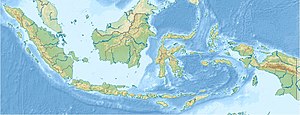Our website is made possible by displaying online advertisements to our visitors.
Please consider supporting us by disabling your ad blocker.
Indonesian archipelago
This article needs additional citations for verification. (January 2025) |
Native name: Kepulauan Indonesia | |
|---|---|
 Map of the Indonesian archipelago | |
 Indonesian archipelago on the world map | |
| Etymology |
|
| Geography | |
| Location | Southeast Asia and Oceania |
| Coordinates | 6°10′S 106°49′E |
| Adjacent to | |
| Total islands | ± 17,000–18,000 islands[1][2] |
| Major islands | |
| Area | 1,904,569[3]–8,300,000[4][5] km2 (735,358–3,204,648 sq mi) |
| Highest elevation | 4,884 m (16024 ft)[a] |
| Highest point | Puncak Jaya, Central Papua |
| Administration | |
| Capital and largest city | Jakarta (pop. 10.56 million as of 2020) |
| President | Prabowo Subianto |
| Demographics | |
| Demonym | Indonesians |
| Population | ± 280,000,000 (2023) |
| Ethnic groups | |
The Indonesian archipelago (Indonesian: Kepulauan Indonesia) is a large collection of over 17,000 to 18,000 islands[6][7] located between the Indian and Pacific Oceans in Southeast Asia and Oceania.[8] It is the world's largest archipelago,[9] with five main islands—Sumatra, Java, Borneo (shared with Malaysia and Brunei), Sulawesi, and New Guinea (shared with Papua New Guinea).
Indonesia is famous for its biodiversity, unique animals and ecosystems that range from tropical rainforests to volcanoes, making it one of the most biodiverse countries in the world.[10][11] The cultural heritage of the Indonesian archipelago reflects a profound diversity, encompassing hundreds of distinct ethnic groups and languages. Its strategic location and natural resources have long made Indonesia an important trading center and a major player in regional and global affairs. Influenced by Hindu, Buddhist, Islamic, and European colonial cultures, Indonesia gained independence in 1945.
The Indonesian archipelago consists of about 6,000 inhabited islands, with many others that are uninhabited.[3] These islands range from densely populated Java—often regarded as the economic and cultural heart of Indonesia, home to numerous candi (temples), including Borobudur, the world’s largest Buddhist temple—to small, remote islands. Bali is known as a tourist destination, famous for its nature and culture making it one of the most popular tourist destinations in the world, Sumatra with its natural resources and strategic position on the Malacca Strait, and Komodo with its unique lizards. The Maluku Islands, or Rem-pah Islands, have an important history in the world spice trade.[12]
- ^ "Jumlah Pulau Resmi di RI Capai 17.024, Masih Ada yang Tanpa Identitas". cnnindonesia.com (in Indonesian). 2023-11-20. Retrieved 2020-06-19.
- ^ "Indonesia at a Glance". kemlu.com (in Indonesian). 2023-11-20.
- ^ a b CIA World Factbook Cite error: The named reference "CIA" was defined multiple times with different content (see the help page).
- ^ Faure, Michael G. (2006). Prevention and Compensation of Marine Pollution Damage: Recent Developments in Europe, China and the US. Kluwer Law International. ISBN 9789041123381.
- ^ Frederick, William H.; Worden, Robert L. (2011). Indonesia: A Country Study. Government Printing Office. ISBN 9780844407906.
- ^ Undang-undang RI Nomor 9 Tahun 1996 tentang Perairan Indonesia [Law No 9/1996 on Maritime Territory of Indonesia] (Law 9, Explanatory notes of Law 9/1996) (in Indonesian). People's Representative Council. 1996.
- ^ Purwanto, Heru, ed. (10 January 2017). "Indonesia to register 14,752 officially named islands with UN". Antara News. Retrieved 19 October 2021.
- ^ Frederick, William H.; Worden, Robert L. (1993). Indonesia: A Country Study. Area Handbook Series. Vol. 550. Washington, D.C.: Federal Research Division, Library of Congress. p. 98. ISBN 9780844407906. Archived from the original on 2023-01-20. Retrieved 9 November 2023.
- ^ "Island Countries of the World". WorldAtlas.com. Archived from the original on 2017-12-07. Retrieved 2019-08-10.
- ^ Williams, J. (2001). "Biodiversity Theme Report". environment.gov.au. Archived from the original on 2008-12-08. Retrieved 2019-10-02.
- ^ "Megadiverse Countries definition| Biodiversity A-Z". biodiversitya-z.org.
- ^ "Spices and Their Costs in Medieval Europe". www.economics.utoronto.ca. Archived from the original on 30 October 2020. Retrieved 21 June 2020.
Cite error: There are <ref group=lower-alpha> tags or {{efn}} templates on this page, but the references will not show without a {{reflist|group=lower-alpha}} template or {{notelist}} template (see the help page).
Previous Page Next Page


